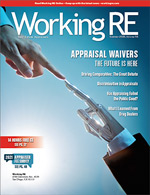 |
“One of the best courses that I have had in 17 years!” -Amy H
>> OREP E&O |
Editor’s Note: Take the NEW 2021 Appraiser Fee Survey online now at WorkingRE.com/2021survey.
Appraisal Waivers: The Future is Here
by Isaac Peck, Editor
Back in 2017, when Working RE interviewed Zachary Dawson, then Director of Collateral Policy & Strategy at Fannie Mae, Dawson reported that Fannie Mae’s use of appraisal waivers was only a few percent of the agency’s total loan production, and that it might increase to 10 percent. “Our enhanced PIW program started December 10, 2016, so delivery volume is still ramping up at this time. We are seeing it used at rates of around 20 percent on limited cashout refinances thus far,” Dawson said at the time.
Four years later, the expansion of Fannie Mae and Freddie Mac’s (the GSEs) appraisal waiver programs has been anything but modest.
According to the American Enterprise Institute’s analysis of the latest publicly available datasets from the GSEs, nearly 46% of all “valuations” for residential mortgage transactions were appraisal waivers in November 2020—with traditional appraisals only being used 54% of the time.
In February 2021, the combined share of waivers rose to 49% of all GSE “valuations.” You read that right, currently appraisal waivers make up approximately 49% of all valuations for GSE mortgage transactions.
This represents nearly nine times the volume of waivers seen in late 2017, from around five percent of total loans to over 45 percent. See Figure 1: Appraisal Waiver Percentage of All GSE Valuations for a graph showing the rapid rise of waivers.

Figure 1: Appraisal Waiver Percentage of All GSE Valuations
Across loan types, nearly 70% of rate and term refinances have received an appraisal waiver; over 30% of cash-out refinances and over 10% of purchases received a waiver in the final months of 2020. See Figure 2: Appraisal Waiver Share by Loan Purpose for details. The GSEs seem to have executed a quiet coup of the appraisal industry, seemingly without appraisers or other industry stakeholders even noticing. Why? Many appraisers report being busier than ever in 2020, with many increasing their fees to handle the extra volume! (To take Working RE’s 2021 Fee Survey, visit WorkingRE. com/2021survey. The results will be published free to the industry.)

Figure 2: Appraisal Waiver Share by Loan Purpose
Here is a closer look at the data, what it means, and what it may tell us about the future.
Not New
The use of appraisal waivers by Fannie Mae and Freddie Mac is not new. In late 2016, the Appraisal Institute (AI) wrote a letter to the GSEs’ head regulator, Mel Watt, then Director of the Federal Housing Finance Agency (FHFA), urging caution with the use of Fannie Mae and Freddie Mac’s appraisal waivers, particularly with purchase loan transactions. AI’s letter points out that in the years leading up to the real estate crash of 2007–2008, Fannie and Freddie were issuing appraisal waivers en masse. After they were taken into conservatorship in 2008, it was discovered that as many as 30 percent of mortgage loans held by Fannie and Freddie had received such waivers, according to AI.
Looking at the GSEs’ own data, that has been analyzed and published by the American Enterprise Institute (AEI), it is safe to say that after the real estate crash of 2007–2008, the use of waivers was significantly cut back and curtailed. Since then, however, the use of waivers has skyrocketed.
Appraisals vs. Waivers
Edward Pinto, Director of AEI, the organization that originally gathered, analyzed and published the GSE’s waiver data, believes that we are currently at the “high mark” of the GSEs’ use of waivers and we should see their use begin to decline in the months ahead. According to Pinto, this is primarily because interest rates should rise in the next few years, which will decrease no-cash-out refinancing, also known as “rate and term” refinancing, causing cash-out refinances and purchase transactions to make up a larger portion of total mortgage activity. Because waivers are now being used on the overwhelming majority of rate and term refinances (nearly 70 percent), rising interest rates should trigger less refinancing activity and consequently, waivers may decline as a percentage of total mortgage activity. That is, unless the GSEs continue to rapidly expand their use. “The prevalence of waivers in purchase transactions may still be going up,” says Pinto. The GSEs’ use of waivers predates the COVID-19 pandemic, Pinto points out. But the pandemic, and the bonanza of refinance and purchase activity that occurred because of historically low interest rates, no doubt played a role in the growth.
Pinto argues that waivers actually are less risky than traditional appraisals, especially for no-cash-out refinances. Because the AEI has their own nationwide AVM, as well as access to all of the GSEs’ recent data, they are able to model what types of loans have received waivers and at what LTV ratios. This has allowed Pinto and his team to conclude that the waivers are coming in lower, in general, on refinances than the traditional human appraisal. In other words, the GSEs are currently being conservative with their models. On the whole, AEI’s model concludes that Freddie Mac’s waiver system is slightly more aggressive than Fannie Mae’s, but that the waiver systems of both GSEs are still providing opinions of value that are slightly lower than those of human appraisers. See Figure 3: Tracking Waivers vs. Human Appraisal.

Figure 3: Tracking Waivers vs. Human Appraisals
Assessing Risk
In terms of the risk involved in appraisal waivers, Pinto explains that the AEI’s primary concern is unscrupulous parties figuring out how to game the system. “I’m cognizant of that fact that when automated methodologies are in the hands of a duopsony, (two buyers controlling the market), they set the market. We are very concerned about that and we need to do more research about how the waiver process might be gamed,” says Pinto.
In terms of what “gaming” the system might look like, Pinto draws comparisons between automated valuation waivers and automated underwriting (AU) that was first implemented back in 1997. “When the actors in a system are able to figure out what the answer is going to be, either in underwriting or in valuation, they can figure out what to input into the system to get the answer they want. For example, when AU started out in the late 1990s, its impact was somewhat benign. However, over time, gaming became rampant, including by Fannie and Freddie themselves. Underwriting standards continued to get looser and looser through 2007, which was a major contributor to the housing boom that ended in 2007 and the subsequent price collapse. AU was supposed to prevent that. They said it was going to be so much safer, but that’s not what happened,” said Pinto.
Pinto argues that waivers face a similar risk. “Key industry players will be able to figure out the GSEs’ model, at which point they’ll know what numbers to input into the system. But it’s not just lenders who could lead this astray. Fannie and Freddie might, for competitive reasons, also decide to get more aggressive with their models, increasing their risk. This would be akin to the house changing the odds as opposed to the players,” Pinto says.
Another concern that Pinto has is that waivers may end up promoting the “up” real estate cycle. “If you have policies that tend to reinforce an upward real estate cycle, this adds more gasoline to the fire. While we don’t see any of that going on today, we are alert to the fact that history tells us we have to be vigilant. AEI now has a benchmark to compare the waiver and the human appraisal processes in the future and we will continue on a quarterly basis,” reports Pinto.
Rodman Schley, MAI, SRA and 2021 President of the Appraisal Institute (AI), says that AI has concerns about the GSEs’ increased risk of waivers. “Not every situation requires an interior or exterior inspection of the subject property, but we do believe that a race to the bottom is taking place and that increased use of waivers adds risk to the consumer, lenders, and ultimately the taxpayer. Just like we saw in 2008 and 2009, failed loans will lead to taxpayers taking on that burden, so our position is that risk management should be paramount,” said Schley.
Anchoring
While there has been much discussion around anchoring, the tendency for the “opinion of value” to match the purchase price or refinance “target,” Pinto points out that there is a significant element of anchoring with appraisal waivers as well. “Anchoring is higher on purchase transactions than on refinance transactions, but is still quite prevalent on refinance transactions,” says Pinto. See Figure 4: Anchoring on GSE Purchase Waivers.

Figure 4: Anchoring on GSE Waivers
In one of its recent infographics, AEI writes that the waiver process “institutionalizes the traditional ‘what do you need?’ anchoring approach common to human valuations. Like the AU process, loan originators may increase the odds of getting the desired result by submitting to both GSEs multiple times if a waiver is not offered on the first try. But if a waiver is not granted, the human appraisal becomes the third bite at the apple.” What’s Up with Appraisal Volume? If appraisal waivers have increased to 46 percent of all GSE mortgage transactions, why are most appraisers as busy as ever?
The answer lies in the correspondingly drastic increase in refinance and purchase transaction volume that took place in 2020. While the data provided by the GSEs is incomplete until 2017/2018, enough data has been published to get a good picture of the growth of waivers as well as the volume of appraisals over the last several years. As we can see from Figure 5, the GSEs’ combined number of mortgage transactions increased from an average of around 350,000 transactions in 2014 through early 2019, to over 800,000 transactions per month throughout the summer of 2020 and then nearly 1,000,000 transactions in November 2020.

Figure 5: Total Mortgage Transactions
This sharp increase in mortgage transactions, more than doubling compared to past years, created an environment where even as the use of appraisal waivers skyrocketed, appraisers still saw the number of assignments allocated to them increase.
As we can see from Figure 6, the number of traditional, human appraisals tracked the number of mortgage transactions very closely from Nov. 2017 into 2019. However, in 2019, a divergence between the two metrics can be noted as waivers begin their rapid ascent. However, even with the very drastic increase in appraisal waivers, it is still notable that the number of human appraisals has continued to increase throughout 2020. In fact, appraisal volume hit a record high in 2020, even as waiver usage increased substantially.
Another piece of good news for appraisers is that Fannie Mae and Freddie Mac do not represent the entire mortgage market. Combined, the GSEs only represent 50 to 60 percent of the mortgage market by loan count. With slightly over six trillion dollars in mortgages on their books, they have a little under 55% of all mortgages outstanding, according to Pinto. Loans made by the Department of Veteran Affairs (VA) and the Federal Housing Administration (FHA) account for roughly 25% of the mortgage market combined; the United States Department of Agriculture (USDA) has a few percent of the market (focused on rural areas), and the rest of the market is made up of private or “inhouse” lending where the banks hold the loans on their balance sheets.
(story continues)
This means that even as Fannie and Freddie seem comfortable waiving appraisals, the other industry participants that make up the other 45 percent of the mortgage market, are not yet moving in that direction.
Looking to the Future
In terms of what to expect, Pinto says that appraisers have to stop complaining about automation, and start talking about what value they bring to the table. “Appraisers should be asking themselves: what is my value add? If appraisers can be replaced by a machine, they will be. If all they’re doing is filling out a bunch of boxes on a form, or putting three comps on a grid, then a machine can do a much better job of that. But if appraisers are bringing knowledge of the fundamentals of the market, and they can articulate the difference between price and value, then they’re adding value and justifying their place in the value chain,” argues Pinto.
Schley also believes that appraisers need to continue to learn and develop their skills. “We should always be working to provide the highest quality product possible. Successful appraisers today and in the future will continue to educate themselves, and learn and grow. AI offers a number of designations for appraisers, and it’s not just about getting a designation, it’s about continuing to learn and develop to be better able to serve our clients. Our folks are some of the most incredible forward-thinking people, who are relentlessly working to bring the highest value to reduce risk. We should always be learning—always expanding,” argues Schley. Schley believes a holistic approach is necessary. “We need to continue sitting down and talking through the issues with the GSEs, lenders, and appraisal service providers. AI is striving to take part in these discussions, so as an industry we can ensure we’re meeting the needs of the people we serve. We need to continue identifying the problems and working together to solve them. It has to be a collaborative approach,” Schley says.
Despite the challenges, Schley argues vehemently against the idea that the appraisal profession is dying. “We are not a dying industry; we are an evolving industry. Yes, things are changing and the way that we do things is changing. AI’s philosophy is that we need to evolve and grow with the changes. The way that you succeed in life is to evolve. If you’re not willing to evolve, if you’re not willing to change, if you’re not willing to learn, then you’re in trouble. The industry has been evolving significantly in the last five–10 years. Successful appraisers will continue to provide the highest quality of products and continue to find ways to improve, change, and evolve to meet the needs of their clients,” says Schley.
To that end, the AI believes that training a new generation of appraisers is integral to the industry’s future. “We want to see a diverse, healthy appraisal industry and recruiting and training new appraisers is a key part of that. We are working to break down some of the barriers to entry for the profession and are also offering scholarships for people to get into the industry. We are working hard to encourage more minorities and women to join the ranks because we believe it’s important that we have a diverse group of appraisers. This industry has been incredibly good to me and it’s a very valuable profession in terms of overall risk reduction for our financial system. That’s why it is so important for our highly skilled appraisers, who have been in the industry for many years, to give back their knowledge and expertise to train the next generation of appraisers,” Schley says. “As an industry, we are going to continue to evolve and change, but we are not on our way out.”
About the Author
Isaac Peck is the Editor of Working RE magazine and the Vice President of Marketing and Operations at OREP.org, a leading provider of E&O insurance for appraisers, inspectors and other real estate professionals in 50 states. He received his master’s degree in accounting at San Diego State University. He can be contacted at isaac@orep.org or (888) 347-5273.
Sign Up Now! $119 (7 Hrs)
OREP Insured’s Price: $99
>Opt-In to Working RE Newsletters
>Shop Appraiser Insurance
>Shop Real Estate Agent
Insurance
Send your story submission/idea to the Editor:
isaac@orep.org






by Vince Slupski
Excellent article! But when interest rates rise, appraisal volume will drop, and appraisers will drop out en masse. Rodman Schley can say what he wants about training the next generation of appraisers – it sounds like training the next generation of radio repairman or switchboard operators. One quote from Ed Pinto really stuck out – “articulate the difference between price and value.” Huh? Is he suggesting that houses have some kind of intrinsic value, or long-run value, or sustainable value, that is different from price? Because the appraisal body of knowledge emphasizes the most probable price as of an effective date. Not the long-term trend in prices, or the predicted value/most probable price 5 years from now. Today’s price. By 2009, every appraisal done in 2007 was worthless, and had failed as a risk management tool, even if competently completed using 2007 data. That’s the problem. Appraisers report a snapshot of market price on the way up, and on the way down. If clients and regulators want something different, they will have to specify what they want. But if an appraiser were to say, “the long-term value trend for this house is $400,000 so that’s its value, despite the pending $500,000 sale,” he or she would be out of business.
-by KRIS L HEISER
Why do your articles always end up with the same conclusion that appraisers are racist? We do not need scholarships and there are no barriers to entry. Work hard, educate yourself, and strive to do better. That is open to ALL people in the United States.
Enough of the propaganda!
-